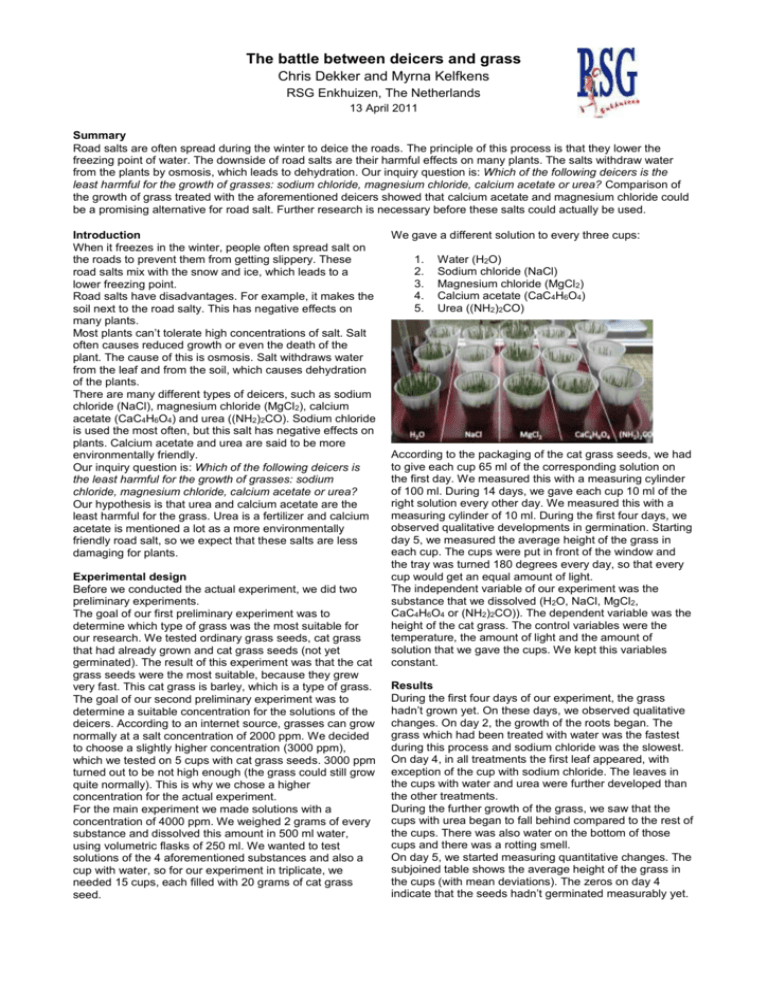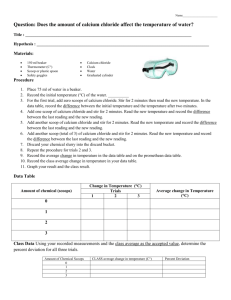The battle between deicers and grass Chris Dekker and Myrna
advertisement

The battle between deicers and grass Chris Dekker and Myrna Kelfkens RSG Enkhuizen, The Netherlands 13 April 2011 Summary Road salts are often spread during the winter to deice the roads. The principle of this process is that they lower the freezing point of water. The downside of road salts are their harmful effects on many plants. The salts withdraw water from the plants by osmosis, which leads to dehydration. Our inquiry question is: Which of the following deicers is the least harmful for the growth of grasses: sodium chloride, magnesium chloride, calcium acetate or urea? Comparison of the growth of grass treated with the aforementioned deicers showed that calcium acetate and magnesium chloride could be a promising alternative for road salt. Further research is necessary before these salts could actually be used. Introduction When it freezes in the winter, people often spread salt on the roads to prevent them from getting slippery. These road salts mix with the snow and ice, which leads to a lower freezing point. Road salts have disadvantages. For example, it makes the soil next to the road salty. This has negative effects on many plants. Most plants can’t tolerate high concentrations of salt. Salt often causes reduced growth or even the death of the plant. The cause of this is osmosis. Salt withdraws water from the leaf and from the soil, which causes dehydration of the plants. There are many different types of deicers, such as sodium chloride (NaCl), magnesium chloride (MgCl2), calcium acetate (CaC4H6O4) and urea ((NH2)2CO). Sodium chloride is used the most often, but this salt has negative effects on plants. Calcium acetate and urea are said to be more environmentally friendly. Our inquiry question is: Which of the following deicers is the least harmful for the growth of grasses: sodium chloride, magnesium chloride, calcium acetate or urea? Our hypothesis is that urea and calcium acetate are the least harmful for the grass. Urea is a fertilizer and calcium acetate is mentioned a lot as a more environmentally friendly road salt, so we expect that these salts are less damaging for plants. Experimental design Before we conducted the actual experiment, we did two preliminary experiments. The goal of our first preliminary experiment was to determine which type of grass was the most suitable for our research. We tested ordinary grass seeds, cat grass that had already grown and cat grass seeds (not yet germinated). The result of this experiment was that the cat grass seeds were the most suitable, because they grew very fast. This cat grass is barley, which is a type of grass. The goal of our second preliminary experiment was to determine a suitable concentration for the solutions of the deicers. According to an internet source, grasses can grow normally at a salt concentration of 2000 ppm. We decided to choose a slightly higher concentration (3000 ppm), which we tested on 5 cups with cat grass seeds. 3000 ppm turned out to be not high enough (the grass could still grow quite normally). This is why we chose a higher concentration for the actual experiment. For the main experiment we made solutions with a concentration of 4000 ppm. We weighed 2 grams of every substance and dissolved this amount in 500 ml water, using volumetric flasks of 250 ml. We wanted to test solutions of the 4 aforementioned substances and also a cup with water, so for our experiment in triplicate, we needed 15 cups, each filled with 20 grams of cat grass seed. We gave a different solution to every three cups: 1. 2. 3. 4. 5. Water (H2O) Sodium chloride (NaCl) Magnesium chloride (MgCl2) Calcium acetate (CaC4H6O4) Urea ((NH2)2CO) According to the packaging of the cat grass seeds, we had to give each cup 65 ml of the corresponding solution on the first day. We measured this with a measuring cylinder of 100 ml. During 14 days, we gave each cup 10 ml of the right solution every other day. We measured this with a measuring cylinder of 10 ml. During the first four days, we observed qualitative developments in germination. Starting day 5, we measured the average height of the grass in each cup. The cups were put in front of the window and the tray was turned 180 degrees every day, so that every cup would get an equal amount of light. The independent variable of our experiment was the substance that we dissolved (H2O, NaCl, MgCl2, CaC4H6O4 or (NH2)2CO)). The dependent variable was the height of the cat grass. The control variables were the temperature, the amount of light and the amount of solution that we gave the cups. We kept this variables constant. Results During the first four days of our experiment, the grass hadn’t grown yet. On these days, we observed qualitative changes. On day 2, the growth of the roots began. The grass which had been treated with water was the fastest during this process and sodium chloride was the slowest. On day 4, in all treatments the first leaf appeared, with exception of the cup with sodium chloride. The leaves in the cups with water and urea were further developed than the other treatments. During the further growth of the grass, we saw that the cups with urea began to fall behind compared to the rest of the cups. There was also water on the bottom of those cups and there was a rotting smell. On day 5, we started measuring quantitative changes. The subjoined table shows the average height of the grass in the cups (with mean deviations). The zeros on day 4 indicate that the seeds hadn’t germinated measurably yet. Day number Day 4 Day 5 Day 6 Day 7 Day 8 Day 9 Day 10 Day 11 Day 12 Day 13 Day 14 H2O 0 2,17 ±0,223 3,30 ±0,267 5,70 ±0,267 7,20 ±0,533 7,70 ±0,467 9,87 ±0,690 10,2 ±0,533 11,0 ±0,767 11,5 ±0,833 11,8 ±1,07 NaCl 0 1,57 ±0,290 2,33 ±0,110 4,83 ±0,510 5,83 ±0,177 6,50 ±0,267 9,23 ±0,423 9,67 ±0,377 10,3 ±0,500 10,8 ±0,500 11,2 ±0,367 Average height (cm) MgCl2 CaC4H6O4 0 0 2,30 ±0,133 1,23 ±0,043 2,87 ±0,090 2,50 ±0 5,90 ±0,133 5,37 ±0,510 7,70 ±0,200 6,77 ±0,777 9,40 ±0,800 8,77 ±0,777 10,6 ±0,100 10,1 ±0,667 11,1 ±0,100 10,5 ±0,633 11,7 ±0,233 11,3 ±0,700 12,1 ±0,367 11,7 ±0,900 12,5 ±0,367 12,0 ±0,967 Average height (cm) The average height of the grass in the cups is also presented in the following graph. We left out the first 3 days, because the seeds hadn’t germinated yet during those days. Starting day 10, the differences between the treatments remained the same. The order of the leaf height was (from low to high): urea, sodium chloride, water, calcium acetate and magnesium chloride. 13 12 11 10 9 8 7 6 5 4 3 2 1 0 H2O NaCl MgCl2 CaC4H6O4 (NH2)2CO 4 5 6 7 8 9 10 11 12 13 14 Day number Discussion and conclusion We observed a difference in the effects of the solutions between the first and second phase of germination. In the first phase (the appearance of roots), the salts slowed down the germination. The best results were obtained with water and sodium chloride retarded germination the most. Because water, light, oxygen and an appropriate temperature are the only requirements for germination, it is likely that salt affects the water uptake and slows down germination. We only observed qualitative changes. Quantitative measurements of the germination may confirm these results. In the second phase (the leaf growth), the best results were obtained with magnesium chloride, calcium acetate and water. Magnesium chloride seems to give the best result. An explanation for this could be that magnesium is an important fertilizer. There doesn’t seem to be a significant difference between calcium acetate and water. Magnesium chloride and calcium acetate are therefore (NH2)2CO 0 2,07 ±0,180 2,43 ±0,377 4,37 ±0,790 5,73 ±1,31 6,73 ±1,31 7,73 ±1,31 8,40 ±1,20 9,13 ±1,04 9,57 ±1,11 10,2 ±1,23 promising alternatives for road salt. The effect of sodium chloride is as expected: compared to water, it reduces the growth of the grass. The growth with urea is clearly the most retarded. It seems like urea slows down the water uptake. An explanation for this could be that urea can immediately be used to produce proteins, so the plant doesn’t have to uptake extra water to correct the osmotic pressure. Therefore, there was water on the bottom of the cups. This caused rotting, which affected the growth even more. Although urea can be used as a fertilizer, it is known that the concentration can easily get too high. This is confirmed by preliminary experiment 2, where we used a lower concentration (3000 ppm), and in which urea did best. Since the concentration of urea can easily get too high, urea isn’t very suitable as a deicer. Our hypothesis was that urea and calcium acetate would be the least harmful for the grass. The results show that urea isn’t a good alternative for road salt. Calcium acetate could be a promising alternative. Further research has to show what the effect of other concentrations of calcium acetate is, before this salt could be used as an alternative for road salt. Evaluation For a more valid conclusion, more repetitions of the experiment are needed. The control variables should also be kept even more constant by using an incubator and a lamp instead of sunlight. Further inquiry questions could be: What is the salt tolerance of different plant species?, What is the influence of the deicers: sodium chloride, magnesium chloride, calcium acetate and urea on only the germination of the plants?, In which concentration is urea not damaging for plants and good enough to melt ice? Bibliography 1. 2. 3. 4. 5. 6. 7. 8. www.pzc.nl/regio/zeeland/6109963/Wegbermenlijden-onder-strooizout.ece http://nl.wikipedia.org/wiki/Strooizout www.crystaldimensions.nl/zeemineralen.php www.asdlib.org/onlineArticles/ecourseware/Mana han/GreenChemManahan%20PPT/GreenChmCh 3%20copy.ppt www.yara.nl/industrial_solutions/chemicals/techni cal_urea/solid_urea/index.aspx www.brazosindustrial.com/mag.htm http://ruudendiana.webs.com/bijzonderekiemers.h tm http://nl.wikipedia.org/wiki/Ureum#Bemesting








